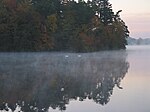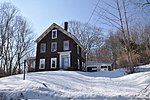Jewell Town District
1687 establishments in the Thirteen ColoniesBuildings and structures completed in 1687Historic districts in Rockingham County, New HampshireHistoric districts on the National Register of Historic Places in New HampshireNRHP infobox with nocat ... and 3 more
National Register of Historic Places in Rockingham County, New HampshireSouth Hampton, New HampshireUse mdy dates from August 2023

The Jewell Town District of South Hampton, New Hampshire, encompasses a colonial-era industrial village with a history dating to 1687. It is centered at the junction of West Whitehall and Jewell Streets, which is just south of a bend in the Powwow River, the source of the power for the mills that were built here. The area was settled in 1687 by Thomas Jewell, and by the early 19th century included a variety of mills as well as a bog iron works. The district now includes only remnants of its industrial past, and features a collection of 18th and early-19th century residential architecture. The district was listed on the National Register of Historic Places in 1983.
Excerpt from the Wikipedia article Jewell Town District (License: CC BY-SA 3.0, Authors, Images).Jewell Town District
Whitehall Road,
Geographical coordinates (GPS) Address Nearby Places Show on map
Geographical coordinates (GPS)
| Latitude | Longitude |
|---|---|
| N 42.872777777778 ° | E -70.968888888889 ° |
Address
Whitehall Road
Whitehall Road
03827
New Hampshire, United States
Open on Google Maps










